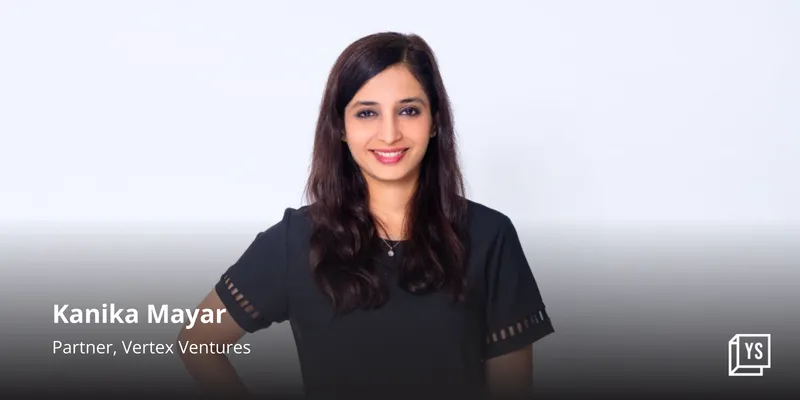Why Vertex Ventures is so bullish about the Indian startup ecosystem
Singapore-headquartered venture capital firm Vertex Ventures aims to increase the number of startup investments in India and is also looking to expand its focus.
Over the last decade, Vertex Ventures Southeast Asia and India has been steadily investing in the Indian startup ecosystem, tapping into the country’s large working population, favourable policies, growing internet base, and increased consumption.
Since its entry in India in 2013-14, the Singapore-headquartered early-stage venture capital (VC) firm has made around 30 startup investments along with a few exits. It counts unicorn startups including , , and in its portfolio.
Vertex Ventures has raised five funds till now, with the latest fund, Fund V, garnering $541 million last year against its target of $450 million. The VC firm also has a presence in the US, China, and Israel.
“With every successive fund, we are becoming bullish on India,” says Kanika Mayar, Partner at Vertex Ventures, in a conversation with YourStory.
It is now looking to expand the scope of its investments in India by increasing the number of deals as well as entering new segments. This bullishness stems from two defining factors: the growing number of high-quality founders and the strong economic indicators of the country.

Mayar says the Indian startup ecosystem has matured very well over the years with the emergence of high-quality founders who are serious about building businesses for the long term.
Investment thesis
Till now, Vertex Ventures in India has been focused on four segments for startup investments—consumer tech, fintech, software-as-a-service (SaaS), and healthtech. It now also wants to invest in segments such as mobility, sustainability, and clean energy.
According to Mayar, the VC firm looks to replicate its past success of building scalable businesses with strong unit economics in the newer segments as well. It will increase the number of startup investments from the earlier average of 3-4 per year to around 5-7 annually.
“We aim to keep within a pace of investment which is manageable,” she adds.
The VC firm considers shifting trends in some sectors an opportunity. In the consumer tech space, the increasing affluence of consumers combined with the willingness to spend more prompted Vertex to fund businesses such as Pilgrim, a personal beauty care brand.
It has also taken certain contrarian bets like Licious, an online meat-selling platform. Mayar says, “When we first invested, a lot of people did not believe that we could build a digital-first meat and seafood company as it is offline. It also took time for us to become comfortable.”
Similarly, in the fintech and enterprise SaaS segments, it believes there are enough opportunities to build scalable businesses. From SaaS, there is the expectation of building a global company out of India while in the fintech space, there is an opportunity to build a scalable business catering to particular consumer segments.
Even as Vertex Ventures looks to expand its reach, it wants to stick to pre-Series A and Series A investment stages, with ticket sizes in the range of $4-6 million in each company. Mayar says through the fifth fund, Vertex will now have the ability to do follow-on rounds in select startups.
Exits
While the VC inflow into Indian startups is nowhere near the 2021 levels, it has stabilised to a certain extent. However, investors are still doubtful about the route of exit — either through an M&A or an IPO.
Mayar says that during Vertex’s early years in the Indian startup ecosystem, there were questions about its ability to get exits. So far, it has had a good tiding. The VC firm has exited from baby care and mother-care startup FirstCry and logistics solution platform Xpressbees.
Also, several other startups in its portfolio were acquired, including Active.Ai by Gupshup, Cloudcherry by Cisco, Flutura by Accenture, Glowroad by Amazon etc. One of its portfolio companies, Yatra, went public last year through a listing on Nasdaq.
“We have learnt not only how to invest but also how to exit and this gives us more confidence that we should go more bullish in India,” says Mayar.
Vertex Ventures has also dedicated $50 million from its fifth fund to back women-led startups. Mayar says while the VC firm always had a focus on women-led ventures, the separate amount comes as both a formality and a signal that it is willing to back good companies led by women founders.
Vertex has earlier invested in women-led startups such as Karkhana.io and Proactive for Her.
The present funding environment for startups is not upbeat as investors are still cautious as diligence becomes much more stringent. However, Mayar says there is enough capital available in the ecosystem but the investment bar for both founders and investors is now higher.
“There are very good founders to meet and back though the question is when to invest,” she remarks.
Overall, Vertex Ventures continues to be positive about the Indian startup ecosystem and believes in the philosophy of backing businesses over 8-10 years. It also offers a global perspective, which helps guide startups.
Mayar says the relationship between the startup founder and investor is always a two-way street where as much as startups pitch to them, they are also pitching to the startups. “Our objective is to be a little ahead of the market.”
Edited by Kanishk Singh









